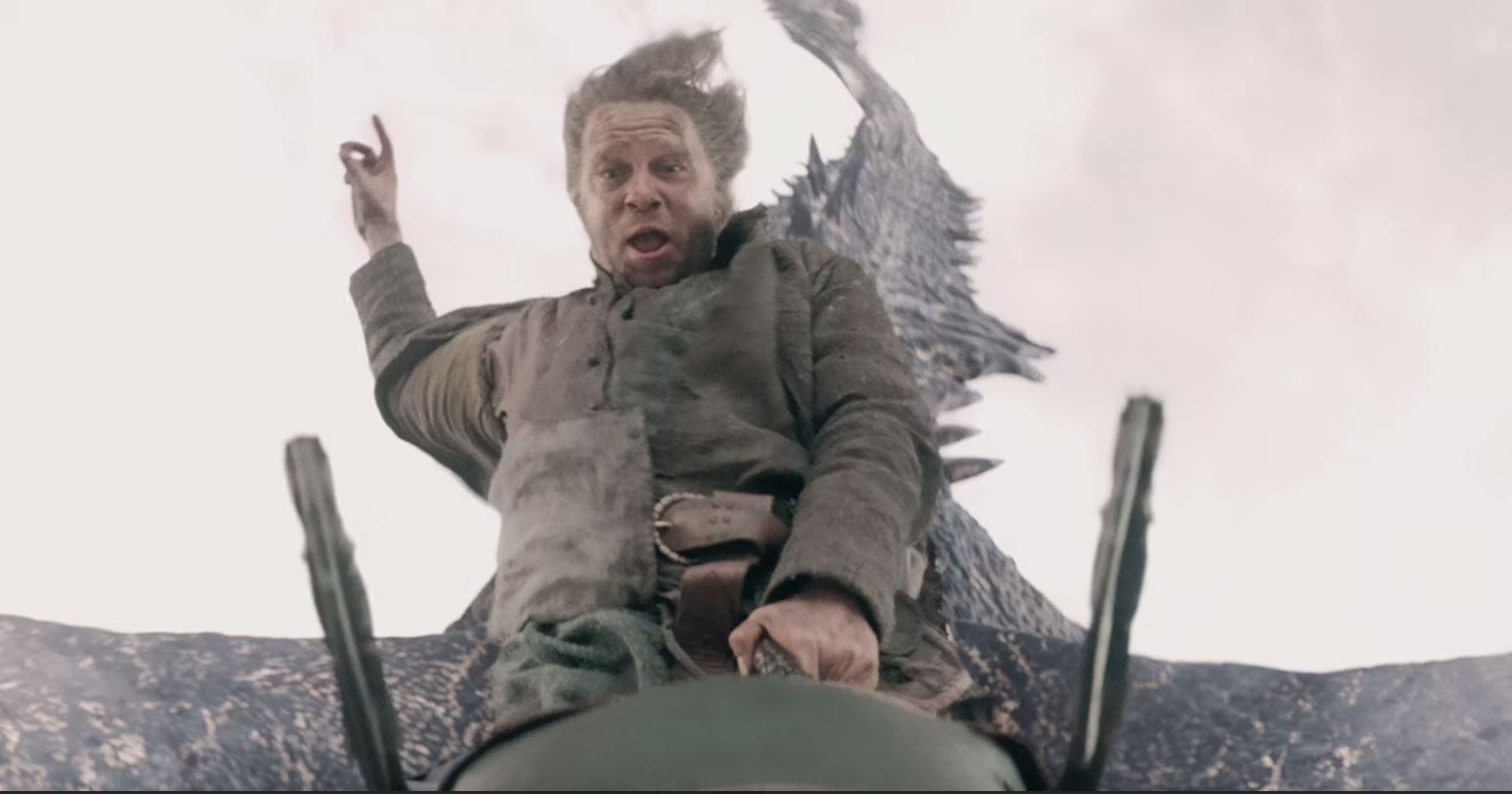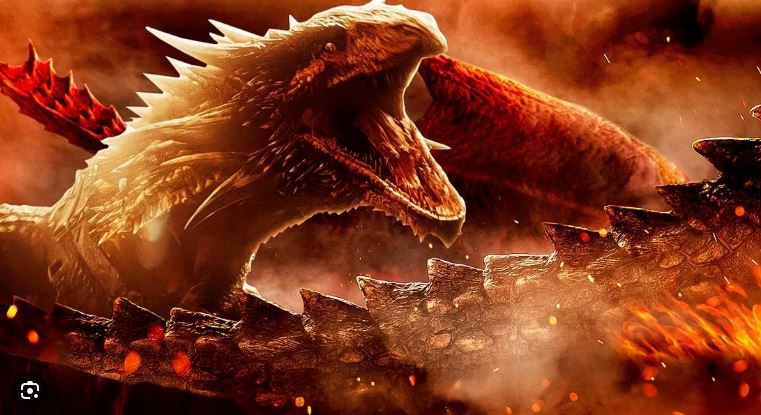It’s always great when someone claims a dragon in House of the Dragon. Those are always the most exciting moments in an episode, and it has happened a lot in Season 2. In Episode 7, “The Red Sowing,” it happens twice, and the episode ends on a high note with Aemond Targaryen (Ewan Mitchell) and his dragon, Vhagar, chasing Ulf the White (Tom Bennett) and Silverwing from King’s Landing to Dragonstone. There are two notable things in this scene. First, Ulf’s excitement, practically “yeehawing” as he flies a dragon for the first time over his hometown. Second, the fact that the following chase takes a little under two minutes in the episode. This has raised some questions about dragons and how they fly. How fast are they, really? Unfortunately, to answer that, we’ll have to do some math, so bear with us.
Dragonstone and King’s Landing Aren’t Really That Close
The chase sequence happens very quickly, giving the impression that either King’s Landing and Dragonstone are really close, or Vhagar and Silverwing are very fast, when in fact, neither of those is true. Westeros is actually huge, and, looking at a map, the capital and the seat of House Targaryen are indeed close, but it’s important to remember that we are dealing with continental proportions. Westeros isn’t a country, but a continent, and it’s roughly around the same size as South America — and South America is huge (yours truly would know).
To be precise, South America is around 6,860,000 square miles (17,840,000 square kilometers), but is completely different from Westeros in shape, which means that some calculations still have to be made when trying to figure out distances. George R.R. Martin has never given accurate dimensions to Westeros to keep fans from doing what we are doing right now — math — and saying that it’s impossible for Vhagar to reach Dragonstone so fast from King’s Landing. The maps of Westeros all come without scaled dimensions, for example. The only piece of accurate data he ever gave is that the Wall is 300 miles (482 kilometers) long. So, using this information as a basis for scaling, the distance between King’s Landing and Dragonstone is 400 miles (643 km).
Also, looking at the Crownlands’ map, it’s also possible to attest that all the major geographical points of the Dance of the Dragons are relatively close. For example, on the way to Dragonstone, Aemond would surely have had to fly over (or at least a visible distance from) Driftmark. In the beginning of the Season 2 finale, “The Queen Who Ever Was,” he attacks the town of Sharp Point, which is also nearby. Even Rook’s Rest is relatively easy to get to. But, again, those are all close in the sense that they are next to each other on the map, because, in terms of geographical distance, not so much.
Dragons Are Fast, but Not as Fast as They Seem

Another issue is that dragons are also never given accurate data about their speed when flying. Martin has only ever written that, for example, Meleys is known to be the fastest dragon in the war, while Vhagar is one of the slowest (although she can vanish and perform sneak attacks). When we think about them, it’s usually in terms of aerial warfare, which leads to the temptation of comparing them to airplanes. The cruising speed of an Airbus A320, largely used for domestic flights, is 598 mph (962 km/h), meaning it would cover the distance between King’s Landing and Dragonstone in around 40 minutes.
According to unofficial estimates, Vhagar is around 150 meters long, bigger than an Airbus A320 (37 meters). But dragons don’t fly like airplanes. They don’t have engines, have to support their own weight using only their wings, and get easily tired. So, going back to the books, the closest information available about how fast dragons are comes from Jacaerys Velaryon (Harry Collett) in Fire & Blood, saying that dragons are faster than ravens. Ravens usually fly at a speed of between 25 and 40 mph (40 and 64 km/h), so it’s reasonable to assume that dragons would fly at least faster than that, reaching perhaps between 30 and 50 mph (48 and 80 km/h). If that’s the case, an average dragon would take at least four hours to reach Dragonstone from King’s Landing, making for a rather boring and tiresome chase. But Vhagar is slow, so she could take even longer.
All these calculations still feel weird when put in the context of House of the Dragon andGame of Thrones, though. Daemon (Matt Smith) took roughly the same time to get from Dragonstone to Harrenhal on dragonback as Ser Alfred Broome (Jamie Kenna) on horseback, for example. In the finale, Rhaenyra (Emma D’Arcy) and Addam of Hull (Clinton Liberty) cover the same distance in two scenes time. In Game of Thrones Season 7, Daenerys (Emilia Clarke) takes her three dragons, known to be smaller than the average dragon in House of the Dragon, from Dragonstone way beyond the Wall to rescue Jon Snow (Kit Harington) in minutes.
Dragons and Distances Don’t Matter in the Context of the Story
Given all the variation in the time the dragons take to cover whatever distance they are required to, it’s reasonable to say that Martin is correct in not wanting fans to concern themselves with precise information about geographical distances and dragon speed. Dragons fly at the speed the story requires them to. Rhaenyra and Addam reach Harrenhal much faster than Daemon because it was necessary for the proper flow of the episode. Daenerys and her dragons didn’t break any speed records when flying beyond the wall, they just left Dragonstone in one scene and arrived at their destination in the next.
This is a typical storytelling tool. It isn’t supposed to make sense, but to make it more dynamic. When scientific measures come into play, stories like House of the Dragon and Game of Thrones stop making sense, and they are fantasy stories at their core — they aren’t supposed to make this kind of sense. In Star Wars, for example, traveling through hyperspace also takes as long as the story requires it to, because, otherwise, those stories would simply be impossible to tell. The chase sequence in “The Red Sowing” may have lasted four hours for Aemond and Ulf, but it doesn’t seem likely that it did. Otherwise, Ulf, who had to do it back and forth between Dragonstone and King’s Landing, would have taken a total of eight hours on Silverwing’s back, and this doesn’t seem likely, nor reasonable. Ulf would have probably gotten bored by the time Silverwing first reaches King’s Landing, and no yeehaws would have been offered.
